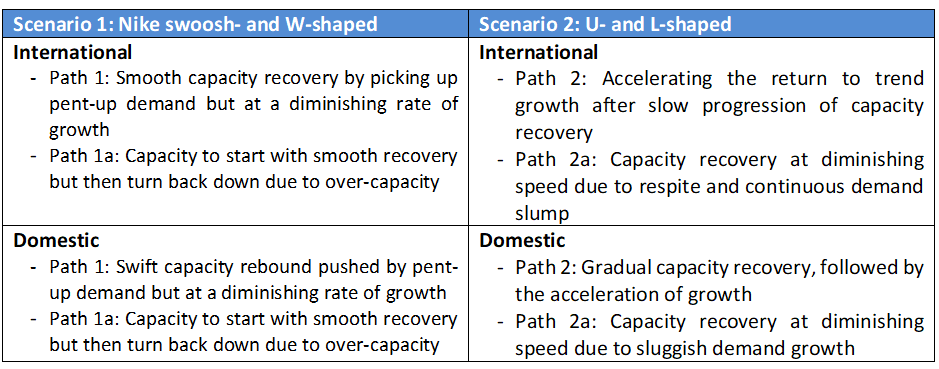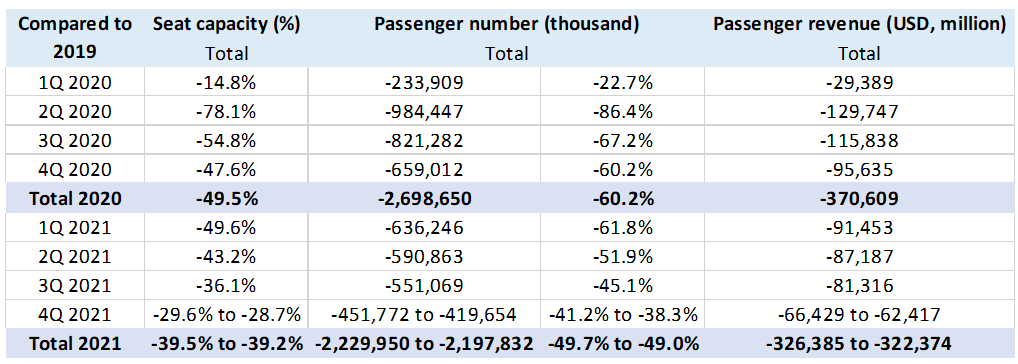The COVID-19 pandemic has had a devastating impact on the aviation industry worldwide with enormous social and economic consequences at large. The unprecedented shock was larger than previous disruptive events like September 11th, SARS, and the global financial crisis. To be able to curb the spread of the virus and confine the pandemic, around the world flights were suspended, borders closed, and there were enforced lockdowns and stringent travel restrictions. These measures significantly reduced global mobility, inevitably resulting in a drastic decline in the demand for air travel. All of it had an unprecedented economic impact.
Prolonged downturn with extremely high uncertainties
When compared with the previous events that affected aviation, there are several ways the current pandemic crisis is unprecedented: the worldwide scale of the virus spread; the longer than anticipated impact; the highly infectious and fast mutation of the virus; and the renewed waves of outbreaks in different countries/regions at different times.
Contending with the rapid pandemic evolution and remarkably high uncertainties surrounding it, governments remained vigilant in standing down restrictions and were extremely cautious in opening up economies and international travel. These high uncertainties called for analyses with a better understanding of the depth and severity of the downturn. They also called for projections in how the recovery was expected to take place as an essential gauge for governments, and all aviation players, in planning strategic and tactical actions throughout the recovery phase.
Scenario analysis and structuring
With the COVID-19 pandemic accelerating across the globe, and headwinds to air transport remain particularly pronounced, even the near-term outlook remains highly uncertain and various growth outcomes are possible. This article explains the scenario analysis used in ICAO’s Economic Impact Analysis of COVID-19 Pandemic on Civil Aviation to help gauge a range of plausible near-term traffic trends and economic implications.
Scope of analysis
The scenario analysis focuses on simultaneous supply shock and drops in demand in the near-term, i.e. within one year, and in terms of scheduled international and domestic passenger traffic globally and regionally. The distinction is made between international and domestic, seasonality, and between geographical regions and route groups, taking into account their heterogeneities. The analysis is based on forward-looking scenarios[1], and is being continuously adjusted and updated with the latest development in the pandemic situation.
Analytical consideration
Before structuring the scenarios, the following factors are considered for each region and for international and domestic traffic separately: geographical disparity of international-domestic passenger traffic mix; the difference in market size among regions; the potential difference in resilience and speed of recovery; outbreak timing that impacts when traffic would bottom out; and the gap between what is scheduled and actual operations.
Shapes of economic recession and recovery
The following shapes of economic recession and recovery have been considered:
- V-shaped: normal shape for recession, a brief period of sharp economic decline followed by quick/smooth recovery
- U-shaped: prolonged contraction and muted recovery to trend line growth
- L-shaped (depression): the long-term downturn in economic activity, steep drop followed by a flat line with the possibility of not returning to trend line growth
- W-shaped: a double-dip recession, “down up down up” pattern before full recovery
- “Nike swoosh”-shaped”: bounce back sharply but blunt quickly
Further considerations have been made on factors that could affect the recovery of air travel. These factors include: How long will the pandemic last and what will be the severity levels? How deep and how long will the global recession be? How long will lockdowns and travel restrictions continue? How fast will consumer confidence in air travel be restored? Will there be a structural shift in industry and consumers’ behaviors? How long can the air transport industry withstand financial adversity?
Indicative scenarios and paths
Four different possible paths under two indicative scenarios were developed by taking into account combinations of various factors affecting traffic recovery. Separate scenarios/paths were also developed for international and domestic passenger traffic that considered their differences and also the much more strict international travel restrictions under the unique situation created by the pandemic.
The exact path (depth, length, and shape) will depend upon various factors, inter alia, duration and magnitude of the outbreak and containment measures, availability of government assistance, consumer confidence, and economic conditions. With the situation evolving and more information available, scenarios will be adjusted as necessary.
Scenario projection results
Based on these scenarios and paths, the near-term air passenger traffic and economic impact was projected globally and for each of the six geographic regions. The impacts were analyzed for three key indicators: a change in passenger seat capacity (supply, %); a change in passenger numbers (demand); and a change of gross passenger operating revenues of airlines (economic impact). To show the depth of the impact, monthly, quarterly and annual comparisons were made to the baseline scenario (business as usual), 2019 levels, and 2020 levels (for 2021 projections), with break-downs by international and domestic. This figure presents the projections (updated on 26 October 2021) compared to 2019.
[1] With multiple scenarios or broad ranges, the forecasts can be more trusted by the market because rationale market players understand that a single scenario entails overstate or understate risks. Toru Hasegawa further looks at this in his article “The less precise information is, the more credible it may be – The question is: what makes the information credible?”.
About the authors
Toru Hasegawa has served as Deputy Director, Economic Development in the Air Transport Bureau of ICAO since January 2015. He joined ICAO in 2000, where he served as Chief of the Revenue and Product Management Section and as an economist responsible for economic policy and infrastructure management. Prior to joining ICAO, he worked at Northwest Airlines and the Nomura Research Institute in Japan. He holds a Ph.D., an MA and a BA in economics, from Tokyo University, with a specialization in industrial organization and applied economics of pricing theories. He has published eight books (in Japanese) on airline pricing and economics.
Sijia Chen is an Air Transport Officer, Infrastructure Management in the Economic Regulatory Framework Section of Air Transport Bureau at ICAO who works on various activities in the area of economic development of air transport. She is currently serving as the Secretary of the technical panels to develop policies and guidance on economic, financial, managerial, and organizational aspects of airports and air navigation services, as well as funding and financing for aviation infrastructure development.



